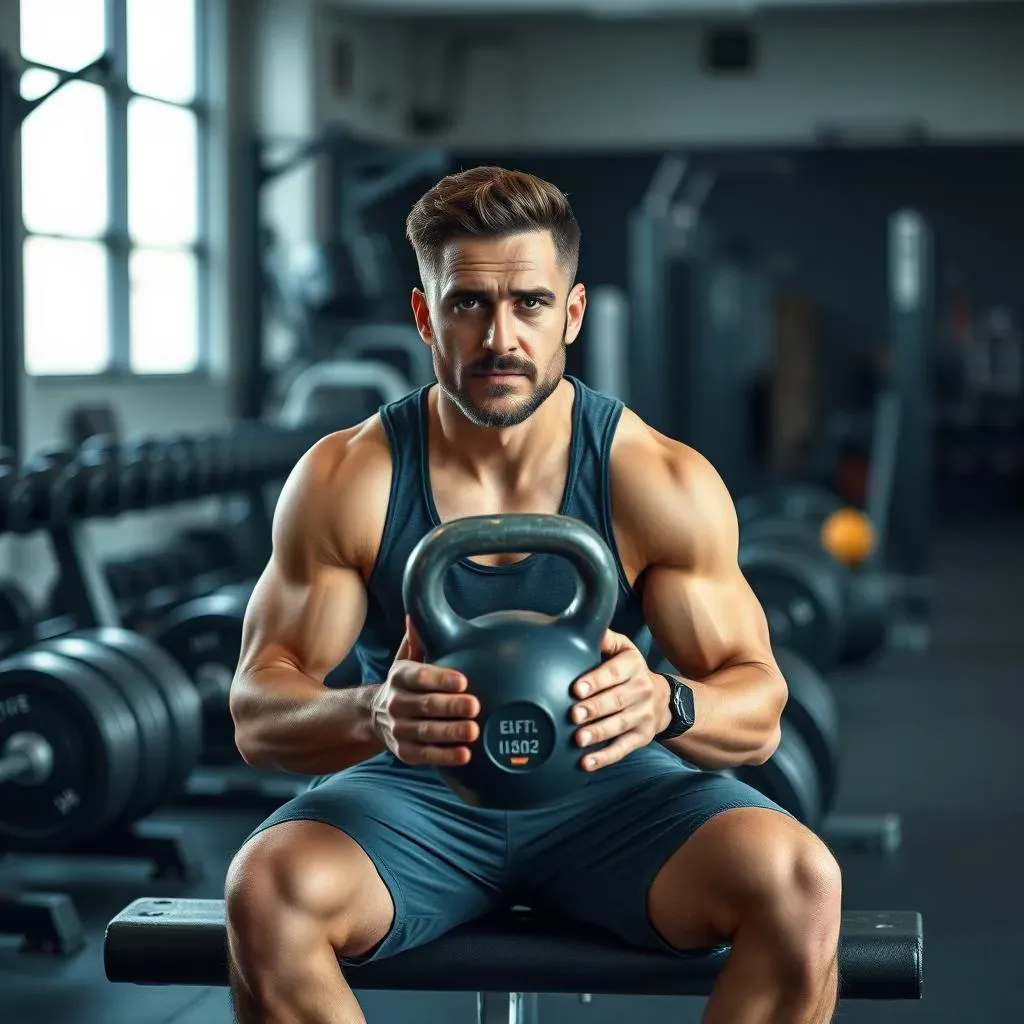Table of Contents
Ever feel like your chest workout is missing something? Like you've hit a plateau, and that lower chest area just isn't responding? You're not alone. Many people focus on the upper chest, neglecting the lower portion, which is key to achieving a well-rounded, powerful physique. That's where the magic of kettlebells comes in. Forget the machines and endless bench presses, we are going to shake things up. This article is your guide to unlocking a stronger, more defined lower chest using the versatility of kettlebells. We'll explore why kettlebells are awesome for this specific goal, dive into the best exercises to get you there, and teach you how to craft an effective "lower chest kettlebell workout" routine. Plus, we'll throw in some sneaky tips to maximize your results. So, if you're ready to take your chest game to the next level, let's get started.
Why Target Your Lower Chest with Kettlebells?

Why Target Your Lower Chest with Kettlebells?
Beyond the Bench Press
so you've been hitting the bench press like a champ, right? But are you really seeing the lower chest definition you crave? Probably not. That’s because traditional chest exercises often prioritize the upper and mid-chest, leaving the lower pecs a bit neglected. Think of your chest like a mountain range; you want to sculpt the whole thing, not just the peaks. Kettlebells offer a unique way to target the lower chest, thanks to their dynamic nature and the way they engage your muscles differently compared to barbells or dumbbells. It's like adding a whole new dimension to your chest day, and trust me, your pecs will thank you for it.
The Kettlebell Advantage
What makes kettlebells so special for the lower chest? It's all about the angles and the instability. Unlike fixed-path machines, kettlebells force you to stabilize the weight throughout the movement. This engages more muscle fibers, including those pesky lower chest muscles that are often left out. The offset center of gravity of a kettlebell creates unique challenges, activating your core and stabilizer muscles along with your chest. You're not just pushing weight; you're controlling it, which leads to greater muscle activation and, ultimately, better lower chest development. Plus, they are fun to use, and who doesn't love a good workout that doesn't feel like a chore?
Benefit | Why it Matters |
|---|---|
Unique Angles | Targets lower chest fibers effectively |
Instability | Engages more muscles for better growth |
Core Activation | Improves overall strength and stability |
Top Kettlebell Exercises for Lower Chest Development

Top Kettlebell Exercises for Lower Chest Development
Kettlebell Floor Press
Alright, let’s get into the good stuff – the actual exercises. First up is the Kettlebell Floor Press. Now, this isn't your average bench press. You're on the floor, which already changes the game. Lie down with a kettlebell in each hand, elbows bent, and the weights resting on the floor by your sides. Then, press the kettlebells up, focusing on squeezing your chest at the top. The floor limits your range of motion, putting more emphasis on the lower chest fibers. It's like a mini-bench press, but with a twist that makes it perfect for targeting that stubborn lower chest. Don't be shy to experiment with different angles to find that sweet spot where you feel that lower chest burn.
Kettlebell Flyes
Next, we have Kettlebell Flyes. These aren't like your typical dumbbell flyes, they're a bit more challenging because of the kettlebell's shape. Lie on the floor, hold a kettlebell in each hand, and extend your arms straight above your chest. Now, slowly lower the kettlebells out to the sides, keeping a slight bend in your elbows. Feel that stretch in your chest? That's what we want. Then, bring them back up, squeezing your chest muscles. The instability of the kettlebells forces your muscles to work harder to control the movement, which is a good thing for growth. Remember to go slow and focus on the muscle contraction. It’s not about how heavy you can lift, but how well you can feel the muscle working.
Exercise | Why it Works for Lower Chest | Key Focus |
|---|---|---|
Kettlebell Floor Press | Limited range targets lower fibers | Squeeze chest at the top |
Kettlebell Flyes | Instability enhances muscle activation | Slow, controlled movements |
Kettlebell Pullovers | Stretches and activates lower pecs | Maintain slight elbow bend |
Kettlebell Pullovers
Finally, let's talk about Kettlebell Pullovers. This is a great exercise for stretching and activating the lower chest. Lie on your back with your feet flat on the floor. Hold a kettlebell with both hands above your chest and then slowly lower it behind your head, keeping a slight bend in your elbows. Feel that deep stretch in your chest? Now, pull the kettlebell back up to the starting position, squeezing your chest. The pullover is not just a chest exercise; it also engages your lats and serratus muscles, making it a great full upper body movement. Make sure you control the weight and don't let it drop too quickly, keep that tension in the chest.
Crafting Your Lower Chest Kettlebell Workout Routine

Crafting Your Lower Chest Kettlebell Workout Routine
Putting it All Together
so now you know the moves, but how do you actually make this into a workout? First off, don't try to be a hero on day one. Start with 2-3 sets of 8-12 reps for each exercise. Focus on form, not how much weight you can lift. It's better to do fewer reps with good technique than to try to muscle through with sloppy form. Think of it like learning a new dance – you wouldn't start with the most complicated choreography, right? You'd start with the basics, and gradually build up. The same goes for your lower chest kettlebell workout.
Also, consider your rest periods. Give yourself enough time to recover between sets, usually around 60-90 seconds. This allows your muscles to recharge before the next round. Don't rush it. Remember, it's not about speed; it's about quality. If you find that your form is breaking down, then it's time to take a bit more of a break. Listen to your body, it knows what it needs.
Sample Routine
Here’s a sample routine to get you started. Do this routine 2-3 times per week, with a day of rest in between. Remember, consistency is key, just like showing up to practice if you are in a band. You won't become a rock star overnight, and you won't get a chiseled chest after just one workout. It's about slowly building up those muscles over time.
Exercise | Sets | Reps | Rest |
|---|---|---|---|
Kettlebell Floor Press | 3 | 8-12 | 60-90 seconds |
Kettlebell Flyes | 3 | 8-12 | 60-90 seconds |
Kettlebell Pullovers | 3 | 10-15 | 60-90 seconds |
Progression and Adaptation
As you get stronger, you can increase the weight, the number of reps, or the number of sets. You can also try adding some variations to the exercises, like doing the flyes with a slight incline or adding a pause at the bottom of the floor press. The key is to keep challenging your muscles. Don't let them get too comfortable, or they will stop growing. It's like a video game – once you master one level, it's time to move on to the next.
Also, don't forget about the importance of rest and recovery. Your muscles grow when you are resting, not when you are working out. Make sure you are getting enough sleep and eating a balanced diet. It's about creating a lifestyle that supports your fitness goals. And most importantly, listen to your body. If you feel any pain, stop and rest. It's not worth injuring yourself for a workout. Your body is your temple, so treat it right.
Advanced Tips and Tricks for Lower Chest Kettlebell Workout

Advanced Tips and Tricks for Lower Chest Kettlebell Workout
Mind-Muscle Connection
so you've got the basic moves down, but let's talk about taking it to the next level. It's not just about lifting the weight, it's about feeling the muscle working. This is what we call the "mind-muscle connection." When you're doing your kettlebell floor press, don't just push the weight up; focus on squeezing your lower chest muscles as you press. It's like you're trying to make your chest muscles touch each other. This conscious effort to engage the right muscles can make a world of difference in your results. It's not magic; it's about being intentional with every rep. Think of it like playing an instrument; you don't just bang on the keys, you focus on each note to create music.
The same goes for kettlebell flyes and pullovers. Feel the stretch in your chest as you lower the weight, and then squeeze those muscles as you bring it back up. The more you can tune into your chest muscles, the more effective your workout will be. It's like having a conversation with your muscles. You need to listen to what they're telling you and respond accordingly. If you're not feeling the lower chest working, then you need to adjust your technique or the weight until you can feel it. It's a constant feedback loop, and the more you practice, the better you'll become at it.
Adding Intensity and Variety
Now that you've mastered the mind-muscle connection, let's spice things up. Don't be afraid to add some intensity to your workouts. Try slowing down the eccentric (lowering) phase of each rep. This increases the time under tension, which is great for muscle growth. You can also try adding some pauses at the bottom of each rep, making the muscles work harder. It’s like adding an extra level of difficulty to a video game. You need to keep pushing yourself to see progress.
And don't forget about variety. Your muscles adapt to the same exercises over time, so it's important to keep them guessing. Try different variations of the kettlebell floor press, flyes, and pullovers. You can do them on a slight incline, or try doing them with different grips. The more variety you add, the more well-rounded your chest development will be. It’s like trying different flavors of ice cream; you need to mix it up to keep things interesting. Your muscles will thank you for it, and your results will be much better.
Tip | How to Implement | Why it Works |
|---|---|---|
Mind-Muscle Connection | Focus on squeezing the chest during each rep | Improves muscle activation and effectiveness |
Slow Eccentric | Lower the weight slowly and controlled | Increases time under tension for better growth |
Pause at Bottom | Pause at the bottom of each rep for a second or two | Adds extra intensity to the exercise |
Exercise Variety | Try different variations of the same exercises | Prevents muscle adaptation and encourages growth |
Wrapping Up Your Lower Chest Kettlebell Journey
So, there you have it. A solid roadmap to building a stronger, more sculpted lower chest using the power of kettlebells. Remember, consistency is key. Don't expect overnight miracles, but with dedication and the right techniques, you'll start to see those results. Embrace the challenge, listen to your body, and most importantly, have some fun with it. Your journey to a powerful lower chest is a marathon, not a sprint. Keep pushing, keep learning, and keep swinging those kettlebells. And hey, if you ever get stuck, just come back and revisit this article. We're here to help you every step of the way. Now go get those gains!